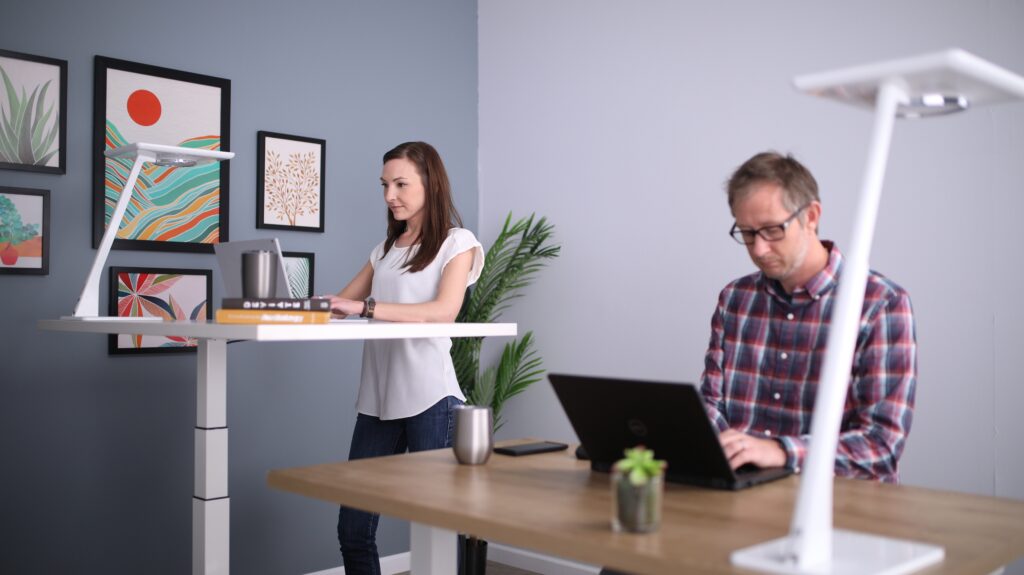Introduction
The pursuit of enhanced productivity and improved health has prompted many individuals to embrace standing desks. While the advantages of working while standing are well-documented, there is a critical factor that is often overlooked: the optimal standing desk height.
To ensure you’re getting the most out of your standing desk, you can use our standing desk height calculator to find the perfect height for you.
PS: If you’ve already decided on getting a desk or need a new one, check out our comprehensive guide on some of the most affordable sit-stand desks you can get right now: Affordable Standing Desks in 2023
The Essence of Ergonomics: Grasping the Concept of Proper Standing Posture
When it comes to standing desks, attaining the correct posture is fundamental. The fundamentals encompass maintaining proper alignment of your head, shoulders, hips, and feet. This neutral spinal curvature forms the basis of ergonomic comfort.

Factors Influencing the Optimal Standing Desk Height: Tailoring to Your Body’s Dimensions
| Individual Height (in feet and inches) | Optimal Standing Desk Height (in inches) |
|---|---|
| 5’0″ | 29-30 |
| 5’2″ | 30-31 |
| 5’4″ | 31-32 |
| 5’6″ | 32-34 |
| 5’8″ | 33-35 |
| 5’10” | 34-36 |
| 6’0″ | 35-37 |
| 6’2″ | 36-38 |
| 6’4″ | 37-39 |
| 6’6″ | 38-40 |
Just as a tailor customizes a suit to fit flawlessly, your standing desk should be tailored to match your body’s distinct proportions. Your height significantly influences the positioning of your keyboard, monitor, and work surface. A common mistake is assuming a universal approach. Remember, your workstation should adapt to you, not the other way around.
Upon evaluating your setup, it may become evident that the desk height was not adjusted to your height correctly, leading to an awkward arm angle, slouching, et cetera. This underscores the significance of personalizing your configuration.
The Optimal Range: Indications of a Well-Adjusted Standing Desk Height
Imagine your standing desk height as Goldilocks’ quest for the ideal porridge – it should neither be excessively high nor too low, but rather just right. Indicators of a properly adjusted height encompass a relaxed and erect posture, with your wrists and forearms forming a comfortable angle. If you catch yourself slouching or overextending your arms, it’s time for an adjustment.
During initial experimentation with a standing desk, the many grappled with persistent neck discomfort. Turns out that that often the monitor was positioned too low, causing them to tilt their head unnaturally. Altering the monitor height made a significant difference. Evaluate your standing desk height by individually evaluating the comfortability of your neck, back, wrists, shoulders, and forearms.
Determining Your Personal Standing Desk Height: A Step-by-Step Approach
Let’s transition to practical steps. To ascertain your optimal standing desk height, follow these guidelines:
Step 1: Measure Your Elbow Angle
- Stand in a comfortable position with your arms naturally at your sides.
- Bend your elbows at a 90-degree angle.
- Your keyboard and work surface should align with this level to ensure optimal typing comfort.
Step 2: Align Your Monitor
- Your monitor should be at eye level, allowing for direct eye contact.
- If you find yourself tilting your head up or down, it’s time to make adjustments.
Step 3: Position Your Feet
- Keep your feet planted flat on the ground, maintaining a hip-width distance.
- This provides a solid foundation and minimizes discomfort.
Making Necessary Tweaks: Strategies for Adapting Your Desk to Your Needs
Remember, your standing desk arrangement is not set in stone; it’s an adaptable configuration that should evolve alongside your requirements. Here are some tips for refining your setup:
Alternate Between Standing and Sitting: While determining the correct standing desk height is crucial, it’s equally vital to remember that moderation is key. Alternate between standing and sitting throughout the day to prevent fatigue. And while sitting, ensure you maintain a good office chair posture.
Listen to Your Body: Pay attention to any signals of discomfort or strain. If you encounter any discomfort, don’t hesitate to make adjustments.
Beyond Height: Comprehensive Ergonomic Considerations
While achieving the right standing desk height is a pivotal accomplishment, there are other elements to consider for a comprehensive ergonomic arrangement:
Footwear and Anti-Fatigue Mats: Choose supportive footwear and contemplate using anti-fatigue mats to alleviate pressure on your feet and legs. If your looking for a guide on anti-fatigue mats check out this article: Are anti-fatigue mats worth it?
Incorporate Micro-Movements and Breaks: Integrate micro-movements such as shifting your weight or stretching. Take brief breaks to walk around and maintain circulation. For a more dynamic approach, consider the benefits of treadmill desks. Take brief breaks to walk around and maintain circulation. And always be aware of the risks of prolonged sitting.
| Type of Movement/Break | Description |
|---|---|
| Weight Shifting | Periodically shift your weight from one foot to the other to reduce pressure and fatigue on your legs. |
| Neck Stretches | Gently tilt your head from side to side and forward and backward to relieve neck tension. |
| Shoulder Rolls | Roll your shoulders backward and forward to alleviate shoulder stiffness. |
| Leg Raises | Alternate lifting each leg slightly off the ground for a few seconds to promote blood flow. |
| Calf Raises | Rise up onto your toes and then lower your heels to work your calf muscles and stimulate circulation. |
| Standing March | Lift your knees alternately in a marching motion to engage leg muscles and increase circulation. |
| Mini Squats | Bend your knees slightly and then straighten them to engage your leg muscles and prevent stiffness. |
| Deep Breathing | Take a few moments to practice deep, mindful breathing to relax and increase oxygen intake. |
| Walk Break | Step away from your desk for a short walk around the room or office to rejuvenate your body and mind. |
| Stretching | Perform simple stretches like reaching for the ceiling or touching your toes to enhance flexibility and reduce tension. |
Conclusion: Realizing Your Optimal Work Configuration
In the pursuit of productivity and well-being, your standing desk height plays a critical role. By grasping the principles of ergonomics, recognizing your body’s distinct characteristics, and making necessary adaptations, you can establish a workspace that amplifies your performance and comfort. Remember, your standing desk should conform to your needs, not the other way around. Therefore, invest the time to find your optimal range and relish the advantages of a perfectly adjusted standing desk.
As you embark on this ergonomic journey, bear in mind that your well-being is a worthwhile endeavor. Your body will express gratitude through heightened energy levels, diminished discomfort, and enhanced productivity.
Frequently Asked Questions (FAQ)
The optimal standing desk height is crucial for maintaining proper posture and ergonomic comfort while working. It can help prevent discomfort, strain, and musculoskeletal issues associated with standing desks.
While standing desks offer benefits, it’s essential to alternate between standing and sitting throughout the day to prevent fatigue and strain. Moderation is key to maintaining comfort and productivity.
Your standing desk setup should be adaptable to your requirements. Listen to your body for signals of discomfort or strain and make necessary adjustments to ensure a comfortable and ergonomic workspace.
Additional Resources
- Digital Marketing Tools: The Importance of Marketing Tools
 The Importance of Marketing Tools In today’s digital landscape, businesses …
The Importance of Marketing Tools In today’s digital landscape, businesses …Digital Marketing Tools: The Importance of Marketing Tools Read More »
- A Guide to Fundamental Marketing Tools for Businesses
 What are marketing tools? At Opvital, we’re dedicated to shedding …
What are marketing tools? At Opvital, we’re dedicated to shedding …A Guide to Fundamental Marketing Tools for Businesses Read More »
- The Significance of Marketing Tools
 Key Takeaways for Marketing Tools Marketing Tools Overview – Diverse …
Key Takeaways for Marketing Tools Marketing Tools Overview – Diverse … - A Comprehensive NeuronWriter Review: Unveiling Its SEO Powers
 Welcome to Opvital’s in depth NeuronWriter Review. NeuronWriter is more …
Welcome to Opvital’s in depth NeuronWriter Review. NeuronWriter is more …A Comprehensive NeuronWriter Review: Unveiling Its SEO Powers Read More »
Occupational Safety and Health Administration (OSHA) – Computer Workstations eTool:
- Link: OSHA Computer Workstations eTool
- OSHA provides comprehensive information on ergonomics in computer workstations, including tips on setting up standing desks correctly.

